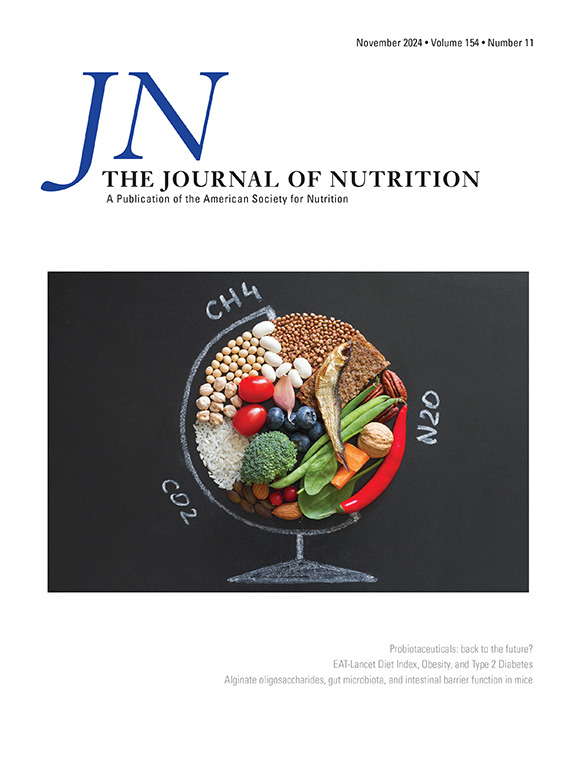4岁时母亲全血硒与心脏结构的关系:一项前瞻性出生队列研究。
IF 3.7
3区 医学
Q2 NUTRITION & DIETETICS
引用次数: 0
摘要
背景:目前对母体血硒水平与子代心脏结构的关系了解甚少。目的:本研究旨在评估妊娠早期母亲全血硒水平与4岁儿童心脏结构的关系。方法:利用上海出生队列的数据,对956对母婴数据进行分析。采用多元线性或逻辑回归和限制三次样条分析探讨母体全血硒水平与子代心脏结构的关系。结果:母体硒水平低与雄性后代收缩期左室后壁厚度(LVPWs) (β = 0.29, 95%CI: 0.06, 0.53)、舒张期左室后壁厚度(LVPWd) (β = 0.17, 95%CI: 0.01, 0.31)和相对壁厚度(RWT) (β = 0.011, 95%CI: 0.003, 0.019)增加有关。母硒与子代左室质量指数(LVMI)(非线性P = 0.002)、LVPWd(非线性P = 0.035)、IVSd(非线性P = 0.006)和RWT(非线性P = 0.013)呈u型曲线关系。然而,在雌性后代中没有发现结构变化的显著关联。与母亲硒水平中等的子代相比,左心室肥厚(LVH)的风险增加(OR = 4.14;95% CI: 1.81, 9.45)仅在母体硒水平较低的雄性后代中发现。结论:母亲低硒水平与学龄前男性子代心脏结构改变和LVH风险升高有关,而与雌性子代无相关性。本文章由计算机程序翻译,如有差异,请以英文原文为准。
Association of Maternal Whole Blood Selenium with Cardiac Structure at 4 y of Age: A Prospective Birth Cohort Study
Background
Currently, little is known about the relationship between maternal blood selenium levels and offspring cardiac structure.
Objectives
This study aimed to evaluate the association of maternal whole blood selenium levels during early pregnancy with children’s cardiac structure at 4 y of age.
Methods
Using data from the Shanghai Birth Cohort, this study analyzed the data from 956 mother–child pairs. Multiple linear or logistic regressions and restricted cubic splines were used to explore the association of maternal whole blood selenium levels with offspring cardiac structure.
Results
Low maternal selenium levels were associated with increased left ventricular posterior wall thickness at systole [β = 0.29, 95% confidence interval (CI): 0.06, 0.53], left ventricular posterior wall thickness at diastole (LVPWd) (β = 0.17, 95% CI: 0.01, 0.31), and relative wall thickness (RWT) (β = 0.011, 95% CI: 0.003, 0.019) in male offspring. Moreover, maternal selenium showed a U-shape curve with left ventricular mass index (P for nonlinearity = 0.002), LVPWd (P for nonlinearity = 0.035), interventricular septal thickness at systole (P for nonlinearity = 0.006), and RWT (P for nonlinearity = 0.013) in male offspring. However, no significant association of structural changes was found in female offspring. Compared with offspring with medium maternal selenium levels, the increased risk of left ventricular hypertrophy (LVH) (odds ratio = 4.14; 95% CI: 1.81, 9.45) was only found in male offspring with lower maternal selenium levels.
Conclusions
Low maternal selenium levels were associated with cardiac structural changes and higher LVH risk in preschool male offspring, whereas no correlation was found in female offspring.
求助全文
通过发布文献求助,成功后即可免费获取论文全文。
去求助
来源期刊

Journal of Nutrition
医学-营养学
CiteScore
7.60
自引率
4.80%
发文量
260
审稿时长
39 days
期刊介绍:
The Journal of Nutrition (JN/J Nutr) publishes peer-reviewed original research papers covering all aspects of experimental nutrition in humans and other animal species; special articles such as reviews and biographies of prominent nutrition scientists; and issues, opinions, and commentaries on controversial issues in nutrition. Supplements are frequently published to provide extended discussion of topics of special interest.
 求助内容:
求助内容: 应助结果提醒方式:
应助结果提醒方式:


